
94% of researchers rate our articles as excellent or good
Learn more about the work of our research integrity team to safeguard the quality of each article we publish.
Find out more
ORIGINAL RESEARCH article
Front. Phys., 17 February 2023
Sec. Atomic and Molecular Physics
Volume 11 - 2023 | https://doi.org/10.3389/fphy.2023.1130225
This article is part of the Research TopicQuantum and Semiclassical Trajectories: Development and ApplicationsView all 11 articles
 Wen-Lei Zhao*
Wen-Lei Zhao* Ru-Ru Wang
Ru-Ru WangWe investigate the dynamics of the out-of-time-order correlators (OTOCs) via a non-Hermitian extension of the quantum kicked rotor model, where the kicking potential satisfies
In recent years, the out-of-time-order correlators (OTOCs) C = −⟨[A(t),B]2⟩ have attracted extensive attention in diverse fields of physics, ranging from quantum chaos [1,2] and quantum information [3] to black hole physics [4]. A fundamental concept in these fields is information scrambling, namely, the spread of information encoding in local degrees of freedoms over the entire system to be inaccessible by local measurement [5–7]. This progress is quantified by the growth of local operators with time evolution, due to which it will be no longer commutable with other operators, separated by a long distance [8,9]. The operator growth is dominated by the classical chaos in such a way that the rate of exponential growth of OTOCs is proportional to the classical Lyapunov exponent [10,11]. Nowadays, the OTOCs are being widely used to diagnose the many-body localization [12,13], quantum entanglement [14–16], quantum thermalization [17–19], and many-body chaos [20–22], hence promoting intensive investigations in the field of many-body physics [23,24]. Interestingly, experimental advances have observed both the quantum information scrambling and quantum phase transition by measuring the OTOCs in the system of the quantum circuit [25,26] and a nuclear magnetic resonance quantum simulator [27].
For
In this context, we investigate, both analytically and numerically, the dynamics of OTOCs in a PTKR model, with focus on the broken phase of
The paper is organized as follows. In Section 2, we show our model and the scaling-law of OTOCs. In Section 3, we present the theoretical analysis of the scaling law. Section 4 contains the conclusion and discussion.
The Hamiltonian of a PTKR reads
with the kicking potential
which satisfies the
The evolution of the quantum state from tj to tj+1 is given by |ψ(tj+1)⟩ = U|ψ(tj)⟩, where the Floquet operator U takes the form
In numerical simulations, one period evolution splits into two steps, namely, the kicking evolution
The eigenequation of the Floquet operator has the expression U|φɛ⟩ = e−iɛ|φɛ⟩, where the eigenvalue ɛ is named as quasienergy. Intrinsically, the quasienergy of the PTKR model is complex, i.e., ɛ = ɛr + iɛi, when the value λ exceeds a threshold value, i.e., λ > λc [54,55], which is a signature of the spontaneous
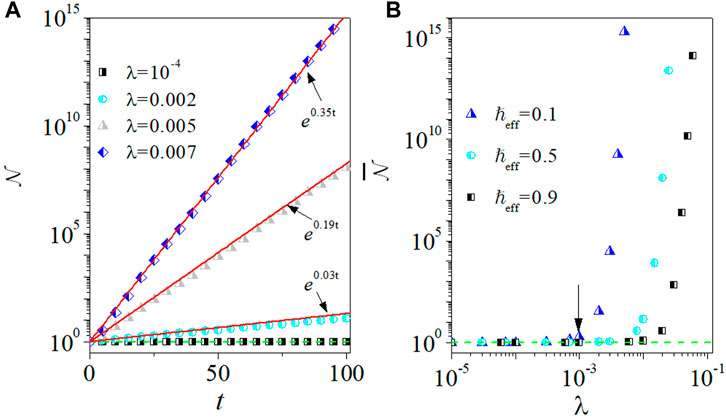
FIGURE 1. (A) Time dependence of
The OTOCs are defined as the average of the squared commutator, i.e., C(t) = −⟨[A(t),B]2⟩, where both operators A(t) = U†(t)AU(t) and B are evaluated in the Heisenberg picture, and ⟨⋯ ⟩ = ⟨ψ(t0)|⋯|ψ(t0)⟩ indicates the expectation value taken over the initial state |ψ(t0)⟩ [23]. It usually uses the thermal states for taking the average in the investigation of OTOCs of lattice systems. For the Floquet-driven system, however, there are no well-defined thermal states, as the temperature tends to be infinity as time evolves [64]. Without loss of generality, we choose a Gaussian wavepacket as an initial state, i.e., ψ(θ, 0) = (σ/π)1/4 exp (−σθ2/2) with σ = 10. We consider the case as A = θ and B = pm
Our main result is the scaling law of the late-time behavior of the OTOCs
where N is the dimension of the momentum space of the PTKR model, and θc = π/2. This prediction is verified by numerical results in Figure 2. As an illustration, we consider m = 1, 2, and 3 in numerical simulations. Figure 2A shows that for a specific m, the C(t) saturates rapidly as time evolves, which is in perfect agreement with our theoretical prediction in Eq. 4. The critical time for the saturation of C decreases with the increase of λ, until saturation (as shown in Figure 2A). In order to further confirm the scaling law of C(t), we numerically investigate the C at a specific time for different values of N. Figure 2B shows that for t = t10, the value of C increases in the power-law of N, which coincides with the theoretical prediction in Eq. 4. The scaling of C(t) with dimensions of the system demonstrates that it diverges as N → ∞, which is of interest in the study of fast scrambling [63]. We would like to mention that we previously found the scaling law for the OTOCs constructed by A = θ and B = p, in a Gross–Pitaevskii map system [65]. Our present work explores the scaling law for B = pm with the arbitrary integer m; moreover, it extends the investigation to non-Hermitian systems, which is evidently a significant advance in the fields of operator growth in chaotic systems.
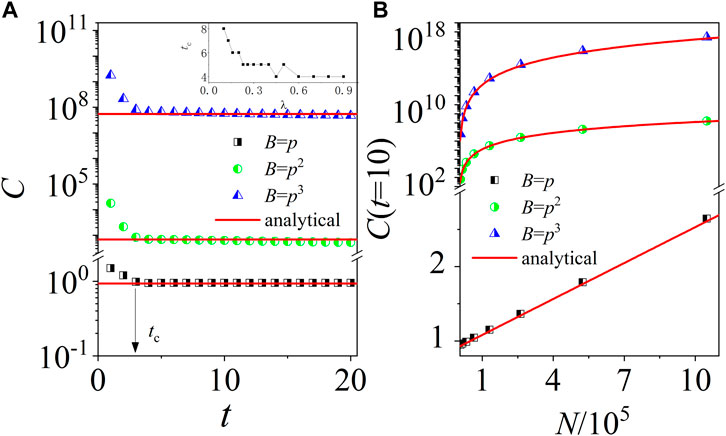
FIGURE 2. (A) Time dependence of C(t) with B = p (squares), p2 (circles), and p3 (triangles) with N = 213. The arrow marks the critical time tc for B = p. Inset: Critical time tc versus λ. (B) C(t) at the time t = t10 versus N. Solid lines in (A,B) denote our theoretical prediction in Eq. 4. The parameters are K = 2π, λ = 0.9, and ℏeff = 0.1.
Straightforward derivation yields the expression of OTOCs
where the three terms in right side are defined by
and
with |ψR (t0)⟩ = U†(tn, t0)θU (tn, t0)|ψ(t0)⟩ and |φR (t0)⟩ = U†(tn, t0)θU (tn, t0)pm|ψ(t0)⟩.
To get the state |ψR (t0)⟩, one needs three steps: 1) forward evolution t0 → tn, i.e., |ψ(tn)⟩ = U (tn, t0)|ψ(t0); 2) action of the operator θ on |ψ(tn)⟩, i.e.,
It is known that in the
We rewrite the C1 as
where
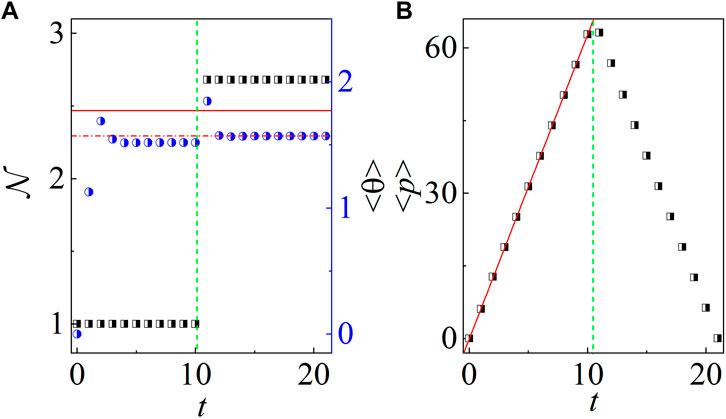
FIGURE 3. Time evolution of

FIGURE 4. Distributions in real (left panels) and momentum (right panels) space. In (A–D), black and red lines indicate the distribution of the states at the forward |ψ(tj)⟩ and backward |ψR (tj)⟩ evolution, respectively, with t = t0 (top panels), t = t5 (middle panels), and t = t10 (bottom panels). In (E–F), red and black lines indicate the distribution of the states |ψ(t10)⟩ and
Figures 4B, D, F show the momentum distribution of the state during both forward and backward evolutions. For the forward evolution, the quantum state behaves like a soliton which moves to a positive direction in momentum space, resulting in the linear increase of the mean momentum, i.e., ⟨p⟩ = Kt (see Figure 3B). The mechanism of the directed acceleration has been unveiled in our previous investigations [29,56]. Intriguingly, at time t = t10, the action of θ yields a state with a power-decayed shape, i.e.,
In the aspect of the mean momentum ⟨p⟩, we find that the value of ⟨p⟩ linearly decreases during the backward evolution and is in perfect symmetry with that of the forward evolution, which is a solid evidence of time reversal. In the end of the backward evolution, the quantum state |ψR (t0)⟩ is localized at the point p = 0 (see Figure 4B). By using the power-law distribution |ψR (p, t0)|2 ∼ p−2, it is straightforward to get the estimation of the expectation value of p2m, i.e.,
which is verified by our numerical results in Figure 5. As an illustration, we consider the cases with m = 1, 2, and 3. Our numerical results of the late-time saturation values of C1 are in good agreement with Eq. 11. It is now clear that the scaling of C(t) with N originates from the power-law decay of the state |ψR (t0)⟩. The reason for the formation of power-law decayed wavefunction has been uncovered in Ref. 65.
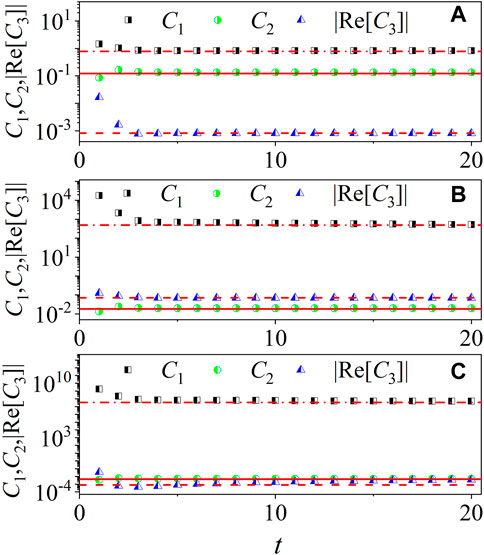
FIGURE 5. C1 (squares), C2 (circles), and
We proceed to evaluate the time dependence of C2(t) in Eq. 7, which is just the norm of the state |φR (t0)⟩ at the end of backward evolution. According to our normalization procedure, the value of C2 equals to the norm of the state
with
where α = 1/(σℏ2) and (…)!! denote a double factorial. Taking both the ⟨θ⟩ and
which is in good agreement with our numerical results in Figure 5.
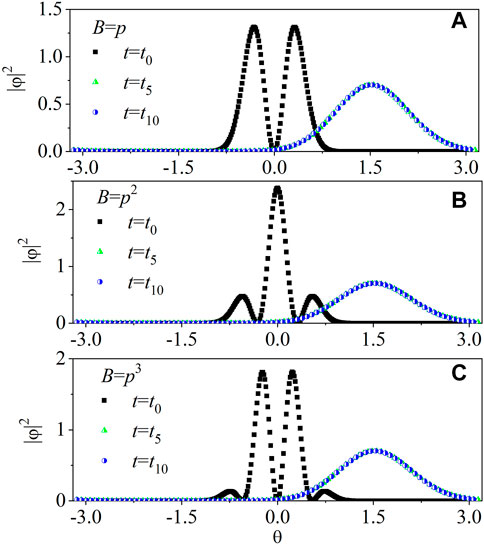
FIGURE 6. Probability density distributions in real space at the time t = t0 (squares), t5 (triangles), and t10 (circles) with B = p (A), p2 (B), and p3 (C). The parameters are the same as in Figure 2.
The value of C3(t) depends on both the states |ψR (t0)⟩ and |φR (t0)⟩ (see Eq. 8). Figure 7 shows the probability density distributions of the two states in both the real space and momentum space. For comparison, the two states are normalized to unity. One can find the perfect consistence between |ψR (t0)⟩ and |φR (t0)⟩. Then, we roughly regard C3 as the expectation value of the pm taking over the state ψR (t0) or φR (t0), i.e.,
Accordingly, the C3 is approximated as
with the prefactor
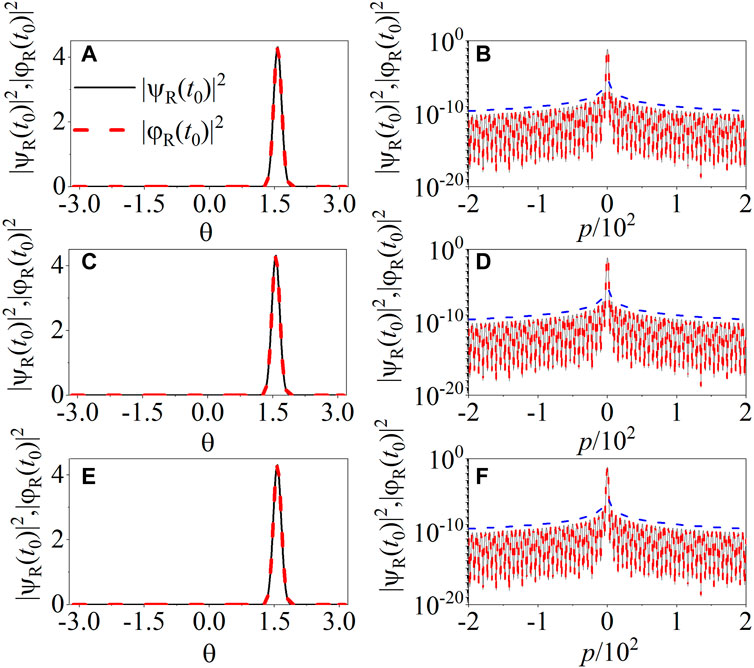
FIGURE 7. Comparison of the distribution of states |ψR (t0)⟩ (solid lines) and |φR (t0)⟩ (dashed lines) in real (A, C, E) and momentum space (B, D, F) with B = p (top panels), p2 (middle panels), and p3 (bottom panels). Blue dashed lines in (B, D, F) indicate the power-law decay |ψR (t0)|2 (|φR (t0)|2) ∝ p−2. The parameters are the same as in Figure 2.
We numerically calculate the absolute value of the real part of C3. Interestingly, our numerical results of |Re [C3]| is in good agreement with the analytical prediction in Eq. 15 (see Figure 5), which proves the validity of our theoretical analysis. We further numerically investigate the |Re [C3(t)]| at a specific time for different N. Figure 8 shows that for B = p, the value of |Re [C3(t)]| is nearly zero with varying N, which is consistent with our theoretical prediction in Eq. 15. For B = p3, the value of |Re [C3(t)]| has slight difference with zero for large values of N, signaling the derivations with Eq. 15. This is due to the fact the quantum state |ψR (t0)|2 is not exactly symmetric around p. In order to quantify such asymmetry, we numerically investigate the difference of the sum of the probability between the positive and negative momentums
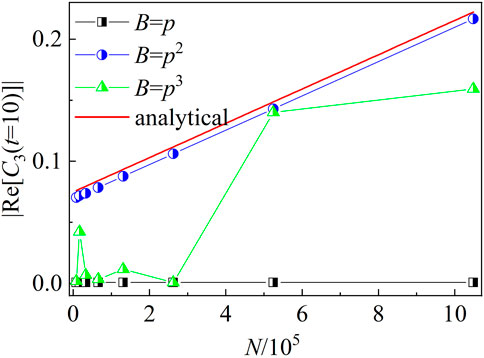
FIGURE 8. |Re [C3(t)]| at the time t = t10 versus N with B = p (squares), p2 (circles), and p3 (triangles). Red solid line indicates our theoretical prediction in Eq. 15 with η = 6.05 × 10−7 for B = p2. The parameters are the same as in Figure 2.
In the present work, we investigate the dynamics of the C(t) = −⟨[θ(t), pm]⟩ in a PTKR model. The spontaneous
In recent years, fruitful physics of quantum many-body systems, such as dynamical phase transition, many-body localization, and thermalization have received extensive studies. It is found that the energy conservation of chaotic systems leads to the scaling law of OTOCs, for which the late-time saturation of OTOCs scales as the inverse polynomial with the system size [66]. For chaotic systems with long-range interaction, the late-time saturation values of OTOCs obey the dynamical scaling law near the phase transition point [67]. Accordingly, our finding of the power-law scaling of OTOCs with the system size of the PTKR model serves as a new element of the quantum information scrambling in non-Hermitian map systems.
The original contributions presented in the study are included in the article/Supplementary Material; further inquiries can be directed to the corresponding author.
W-LZ proposed ideas and revised the manuscript. R-RW conducted the numerical simulation and wrote the manuscript.
This work is supported by the National Natural Science Foundation of China (grant no. 12065009), the Science and Technology Planning Project of Jiangxi province (grant no. 20224ACB201006), and the Science and Technology Planning Project of Ganzhou City (grant no. 202101095077).
The authors declare that the research was conducted in the absence of any commercial or financial relationships that could be construed as a potential conflict of interest.
All claims expressed in this article are solely those of the authors and do not necessarily represent those of their affiliated organizations, or those of the publisher, the editors, and the reviewers. Any product that may be evaluated in this article, or claim that may be made by its manufacturer, is not guaranteed or endorsed by the publisher.
1. Maldacena J, Shenker SH, Stanford D. A bound on chaos. J High Energ Phys. (2016) 08:106. doi:10.1007/jhep08(2016)106
2. Rozenbaum EB, Ganeshan S, Galitski V. Lyapunov exponent and out-of-time-ordered correlator’s growth rate in a chaotic system. Phys Rev Lett (2017) 118:086801. doi:10.1103/physrevlett.118.086801
3. Harris J, Yan B, Sinitsyn NA. Benchmarking information scrambling. Phys Rev Lett (2022) 129:050602. doi:10.1103/physrevlett.129.050602
4. Hayden P, Preskill J. Black holes as mirrors: Quantum information in random subsystems. J High Energ Phys. (2007) 09:120. doi:10.1088/1126-6708/2007/09/120
5. Zanardi P, Anand N. Information scrambling and chaos in open quantum systems. Phys Rev A (2021) 103:062214. doi:10.1103/physreva.103.062214
6. Touil A, Deffner S. Information scrambling versus decoherence—two competing sinks for entropy. PRX QUANTUM (2021) 2:010306. doi:10.1103/prxquantum.2.010306
7. Prakash R, Lakshminarayan A. Scrambling in strongly chaotic weakly coupled bipartite systems: Universality beyond the Ehrenfest timescale. Phys Rev B (2020) 101:121108. doi:10.1103/physrevb.101.121108
8. Zhou T, Xu S, Chen X, Guo A, Swingle B. Operator lé vy flight: Light cones in chaotic long-range interacting systems. Phys Rev Lett (2020) 124:180601. doi:10.1103/physrevlett.124.180601
9. Zhao SK, Ge ZY, Xiang Z, Xue GM, Zhao SP, Wang Z, et al. Probing operator spreading via Floquet engineering in a superconducting circuit. Phys Rev Lett (2022) 129:160602. doi:10.1103/physrevlett.129.160602
10. Yin C, Lucas A. Quantum operator growth bounds for kicked tops and semiclassical spin chains. Phys Rev A (2021) 103:042414. doi:10.1103/physreva.103.042414
11. Moudgalya S, Devakul T, Keyserlingk CV, Sondhi SL. Operator spreading in quantum maps. Phys Rev B (2019) 99:094312. doi:10.1103/physrevb.99.094312
12. Fan R, Zhang P, Shen H, Zhai H. Out-of-time-order correlation for many-body localization. Sci Bull (2017) 62(10):707–11. doi:10.1016/j.scib.2017.04.011
13. Smith A, Knolle J, Moessner R, Kovrizhin DL. Logarithmic spreading of out-of-time-ordered correlators without many-body localization. Phys Rev Lett (2019) 123:086602. doi:10.1103/physrevlett.123.086602
14. Gärttner M, Hauke P, Rey AM. Relating out-of-time-order correlations to entanglement via multiple-quantum coherences. Phys Rev Lett (2018) 120:040402. doi:10.1103/physrevlett.120.040402
15. Keyserlingk CV, Rakovszky T, Pollmann F, Sondhi SL. Operator hydrodynamics, OTOCs, and entanglement growth in systems without conservation laws. Phys Rev X (2018) 8:021013. doi:10.1103/physrevx.8.021013
16. Lerose A, Pappalardi S. Bridging entanglement dynamics and chaos in semiclassical systems. Phys Rev A (2020) 102:032404. doi:10.1103/physreva.102.032404
17. Lewis-Swan RJ, Safavi-Naini A, Bollinger JJ, Rey AM. Unifying scrambling, thermalization and entanglement through measurement of fidelity out-of-time-order correlators in the Dicke model. Nat Commun (2019) 10:1581. doi:10.1038/s41467-019-09436-y
18. Zhu Q, Sun ZH, Gong M, Chen F, Zhang YR, Wu Y, et al. Observation of thermalization and information scrambling in a superconducting quantum processor. Phys Rev Lett (2022) 128:160502. doi:10.1103/physrevlett.128.160502
19. Balachandran V, Benenti G, Casati G, Poletti D. From the eigenstate thermalization hypothesis to algebraic relaxation of OTOCs in systems with conserved quantities. Phys Rev B (2021) 104:104306. doi:10.1103/physrevb.104.104306
20. Kobrin B, Yang Z, Kahanamoku-Meyer GD, Olund CT, Moore JE, Stanford D, et al. Many-body chaos in the sachdev-ye-kitaev model. Phys Rev Lett (2021) 126:030602. doi:10.1103/physrevlett.126.030602
21. Borgonovi F, Izrailev FM, Santos LF. Timescales in the quench dynamics of many-body quantum systems: Participation ratio versus out-of-time ordered correlator. Phys Rev E (2019) 99:052143. doi:10.1103/physreve.99.052143
22. Xu S, Swingle B. Scrambling dynamics and out-of-time ordered correlators in quantum many-body systems: A tutorial. arXiv:2202.07060 quant-ph. (2022).
23. Heyl M, Pollmann F, Dóra B. Detecting equilibrium and dynamical quantum phase transitions in Ising chains via out-of-time-ordered correlators. Phys Rev Lett (2018) 121:016801. doi:10.1103/physrevlett.121.016801
24. Zamani S, Jafari R, Langari A. Out-of-time-order correlations and Floquet dynamical quantum phase transition. Phys Rev B (2022) 105:094304. doi:10.1103/physrevb.105.094304
25. Mi X, Roushan P, Quintana C, Mandra S, Marshall J, Neill C, et al. Information scrambling in quantum circuits. Science (2021) 374:1479–83. doi:10.1126/science.abg5029
26. Weinstein Z, Kelly SP, Marino J, Altman E. Scrambling transition in a radiative random unitary circuit. arXiv:2210.14242 quant-ph. (2022)
27. Nie X, Wei BB, Chen X, Zhang Z, Zhao X, Qiu C, et al. Experimental observation of equilibrium and dynamical quantum phase transitions via out-of-time-ordered correlators. Phys Rev Lett (2020) 124:250601. doi:10.1103/physrevlett.124.250601
28. Zhai LJ, Yin S. Out-of-time-ordered correlator in non-Hermitian quantum systems. Phys Rev B (2020) 102:054303. doi:10.1103/physrevb.102.054303
29. Zhao WL. Quantization of out-of-time-ordered correlators in non-Hermitian chaotic systems. Phys Rev Res (2022) 4:023004. doi:10.1103/physrevresearch.4.023004
30. Berry M. Physics of nonhermitian degeneracies. Czech J Phys (2004) 54:1039–47. doi:10.1023/b:cjop.0000044002.05657.04
31. Ashida Y, Gong Z, Ueda M. Non-Hermitian physics. Adv Phys (2020) 69:249–435. doi:10.1080/00018732.2021.1876991
32. Bender CM, Boettcher S. Real spectra in non-hermitian Hamiltonians HavingPTSymmetry. Phys Rev Lett (1998) 80:5243–6. doi:10.1103/physrevlett.80.5243
33. Bender CM, Brody DC, Jones HF. Complex extension of quantum mechanics. Phys Rev Lett (2002) 89:270401. doi:10.1103/physrevlett.89.270401
34. Zhao XM, Guo CX, Yang ML, Wang H, Liu WM, Kou SP. Anomalous non-Abelian statistics for non-Hermitian generalization of Majorana zero modes. Phys Rev B (2021) 104:214502. doi:10.1103/physrevb.104.214502
35. Yu ZF, Xue JK, Zhuang L, Zhao J, Liu WM. Non-Hermitian spectrum and multistability in exciton-polariton condensates. Phys Rev B (2021) 104:235408. doi:10.1103/physrevb.104.235408
36. Zhao XM, Guo CX, Kou SP, Zhuang L, Liu WM. Defective Majorana zero modes in a non-Hermitian Kitaev chain. Phys Rev B (2021) 104:205131. doi:10.1103/physrevb.104.205131
37. Pino JD, Slim JJ, Verhagen E. Non-Hermitian chiral phononics through optomechanically induced squeezing. Nature (London) (2022) 606:82–7. doi:10.1038/s41586-022-04609-0
38. El-Ganainy R, Makris KG, Khajavikhan M, Musslimani ZH, Rotter S, Christodoulides DN. Non-Hermitian physics and PT symmetry. Nat Phys (2018) 14:11–9. doi:10.1038/nphys4323
39. Xia S, Danieli C, Zhang Y, Zhao X, Lu H, Tang L, et al. Higher-order exceptional point and Landau–Zener Bloch oscillations in driven non-Hermitian photonic Lieb lattices. APL Photon (2021) 6:126106. doi:10.1063/5.0069633
40. Zhang Y, Xia S, Zhao X, Qin L, Feng X, Qi W, et al. Symmetry-protected third-order exceptional points in staggered flatband rhombic lattices. Photon Res (2023) 11(3):225. doi:10.1364/PRJ.478167
41. Xiao Z, Li H, Kottos T, Al u A. Enhanced sensing and nondegraded thermal noise performance based on PT-symmetric electronic circuits with a sixth-order exceptional point. Phys Rev Lett (2019) 123:213901. doi:10.1103/physrevlett.123.213901
42. Chitsazi M, Li H, Ellis FM, Kottos T. Experimental realization of Floquet PT-symmetric systems {PT}}-Symmetric systems. Phys Rev Lett (2017) 119:093901. doi:10.1103/physrevlett.119.093901
43. Zou D, Chen T, He W, Bao J, Lee CH, Sun H, et al. Observation of hybrid higher-order skin-topological effect in non-Hermitian topolectrical circuits. Nat Commun (2021) 12:7201. doi:10.1038/s41467-021-26414-5
44. Kreibich M, Main J, Cartarius H, Wunner G. Tilted optical lattices with defects as realizations ofPTsymmetry in Bose-Einstein condensates. Phys Rev A (2016) 93:023624. doi:10.1103/physreva.93.023624
45. Keller C, Oberthaler MK, Abfalterer R, Bernet S, Schmiedmayer J, Zeilinger A. Tailored complex potentials and friedel’s law in atom optics. Phys Rev Lett (1997) 79:3327–30. doi:10.1103/physrevlett.79.3327
46. Li J, Harter AK, Liu J, Melo LD, Joglekar YN, Luo L. Observation of parity-time symmetry breaking transitions in a dissipative Floquet system of ultracold atoms. Nat Commun (2019) 10:855. doi:10.1038/s41467-019-08596-1
47. Xue Y, Hang C, He Y, Bai Z, Jiao Y, Huang G, et al. Experimental observation of partial parity-time symmetry and its phase transition with a laser-driven cesium atomic gas. Phys Rev A (2022) 105:053516. doi:10.1103/physreva.105.053516
48. Ren Z, Liu D, Zhao E, He C, Pak KK, Li J, et al. Chiral control of quantum states in non-Hermitian spin–orbit-coupled fermions. Nat Phys (2022) 18:385–9. doi:10.1038/s41567-021-01491-x
49. Zhou L, Han W. Driving-induced multiple PT-symmetry breaking transitions and reentrant localization transitions in non-Hermitian Floquet quasicrystals PT-symmetry breaking transitions and reentrant localization transitions in non-Hermitian Floquet quasicrystals. Phys Rev B (2022) 106:054307. doi:10.1103/physrevb.106.054307
50. Zhou L. Floquet engineering of topological localization transitions and mobility edges in one-dimensional non-Hermitian quasicrystals. Phys Rev Res (2021) 3:033184. doi:10.1103/physrevresearch.3.033184
51. Zhou L, Gu Y, Gong J. Dual topological characterization of non-Hermitian Floquet phases. Phys Rev B (2021) 103:L041404. doi:10.1103/physrevb.103.l041404
52. Zhang DJ, Wang Q, Gong J. Time-dependent PT-symmetric quantum mechanics in generic non-Hermitian systems-symmetric quantum mechanics in generic non-Hermitian systems. Phys Rev A (2019) 100:062121. doi:10.1103/physreva.100.062121
53. Longhi S. Oscillating potential well in the complex plane and the adiabatic theorem. Phys Rev A (2017) 96:042101. doi:10.1103/physreva.96.042101
54. West CT, Kottos T, Prosen T. PT-symmetric wave chaos. Phys Rev Lett (2010) 104:054102. doi:10.1103/physrevlett.104.054102
55. Longhi S. Localization, quantum resonances, and ratchet acceleration in a periodically kickedPT-symmetric quantum rotator. Phys Rev A (2017) 95:012125. doi:10.1103/physreva.95.012125
56. Zhao WL, Wang J, Wang X, Tong P. Directed momentum current induced by the PT-symmetric driving. Phys Rev E (2019) 99:042201. doi:10.1103/physreve.99.042201
57. Santhanam MS, Paul S, Kannan JB. Quantum kicked rotor and its variants: Chaos, localization and beyond. Phys Rep (2022) 956:1–87. doi:10.1016/j.physrep.2022.01.002
58. Ho DYH, Gong J. Quantized adiabatic transport in momentum space. Phys Rev Lett (2012) 109:010601. doi:10.1103/physrevlett.109.010601
59. Gadway B, Reeves J, Krinner L, Schneble D. Evidence for a quantum-to-classical transition in a pair of coupled quantum rotors. Phys Rev Lett (2013) 110:190401. doi:10.1103/physrevlett.110.190401
60. Huang KQ, Zhao WL, Li Z. Effective protection of quantum coherence by a non-Hermitian driving potential. Phys Rev A (2021) 104:052405. doi:10.1103/physreva.104.052405
61. Vuatelet V, Rançon A. Effective thermalization of a many-body dynamically localized Bose gas. Phys Rev A (2021) 104:043302. doi:10.1103/physreva.104.043302
62. Belyansky R, Bienias P, Kharkov YA, Gorshkov AV, Swingle B. Minimal model for fast scrambling. Phys Rev Lett (2020) 125:130601. doi:10.1103/physrevlett.125.130601
63. Kuwahara T, Saito K. Absence of fast scrambling in thermodynamically stable long-range interacting systems. Phys Rev Lett (2021) 126:030604. doi:10.1103/physrevlett.126.030604
64. D’Alessio L, Rigol M. Long-time behavior of isolated periodically driven interacting lattice systems. Phys Rev X (2014) 4:041048. doi:10.1103/physrevx.4.041048
65. Zhao WL, Hu Y, Li Z, Wang Q. Super-exponential growth of out-of-time-ordered correlators. Phys Rev B (2021) 103:184311. doi:10.1103/physrevb.103.184311
66. Huang Y, Brandão FGSL, Zhang YL. Finite-size scaling of out-of-time-ordered correlators at late times. Phys Rev Lett (2019) 123:010601. doi:10.1103/physrevlett.123.010601
Keywords: out-of-time-order correlators, PT-symmetry, kicked rotor system, information scrambling, quantum chaos
Citation: Zhao W-L and Wang R-R (2023) Scaling laws of out-of-time-order correlators in a non-Hermitian kicked rotor model. Front. Phys. 11:1130225. doi: 10.3389/fphy.2023.1130225
Received: 23 December 2022; Accepted: 06 February 2023;
Published: 17 February 2023.
Edited by:
Libin Fu, Graduate School of China Academy of Engineering Physics, ChinaReviewed by:
Ruifeng Lu, Nanjing University of Science and Technology, ChinaCopyright © 2023 Zhao and Wang. This is an open-access article distributed under the terms of the Creative Commons Attribution License (CC BY). The use, distribution or reproduction in other forums is permitted, provided the original author(s) and the copyright owner(s) are credited and that the original publication in this journal is cited, in accordance with accepted academic practice. No use, distribution or reproduction is permitted which does not comply with these terms.
*Correspondence: Wen-Lei Zhao, d2x6aGFvQGp4dXN0LmVkdS5jbg==
Disclaimer: All claims expressed in this article are solely those of the authors and do not necessarily represent those of their affiliated organizations, or those of the publisher, the editors and the reviewers. Any product that may be evaluated in this article or claim that may be made by its manufacturer is not guaranteed or endorsed by the publisher.
Research integrity at Frontiers

Learn more about the work of our research integrity team to safeguard the quality of each article we publish.